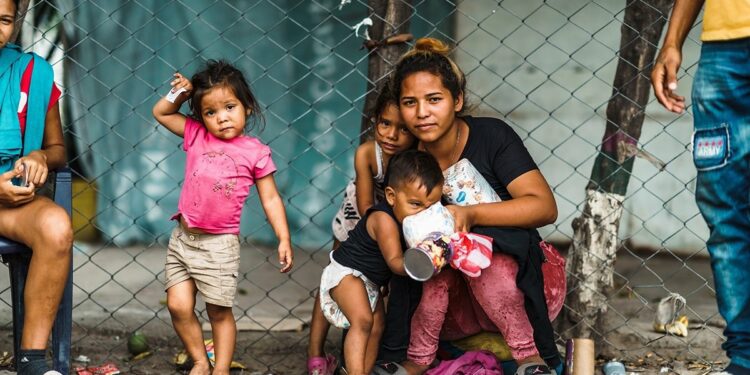Venezuela was once South AmericaтАЩs wealthiest country. Now itтАЩs one of the worldтАЩs least prosperous.┬а
According to United Nations and humanitarian officials, 70% of the people currently heading northward through the treacherous Darien Gap are Venezuelans. But this represents only the latest wave of men, women, and children fleeing the Bolivarian Republic of Venezuela (the countryтАЩs official name). When millions fled the country in the years after 2014, Human Rights Watch described it as the тАЬlargest mass migration eventтАЭ in the modern history of the Americas. By the UN Refugee Agency’s count, that number has now reached nearly 8 million people, approximately one-quarter of the population.┬а┬а
As dangerous and painful as their trek north through the jungle and toward the United States might be, the plight of those who donтАЩt undertake the journey isnтАЩt much better. According to the UN and US Agency for International Development, at the end of last year, 7.6 million people still living in Venezuela needed humanitarian assistance. UNICEFтАЩs latest Venezuela situation report finds that a third of the nation skips one meal dailyтАФ12% go an entire day without foodтАФdue to the prohibitive cost of even the most basic staples.┬а┬а
These numbers give us a sense of how Nicol├бs MaduroтАЩs regime has affected everyday life for its citizens. Other facts and statistics show how Venezuela got to this point.┬а
In the 1970s and 80s, Venezuela was South AmericaтАЩs wealthiest country and one of the top 20 richest countries in the world. It had (and still has) the largest proven oil reserves globally, and in those years when the price of oil was soaring, the government reaped huge revenues. Its citizens prospered: Venezuela had both the lowest levels of economic inequality and the highest growth rates across the region. Even after oil prices declined from historic highs, Venezuela was still in better economic shape than many others. Approximately 25 years ago, Venezuela had a GDP of $122.91 billion and a growth rate of 3.4%. Neighboring ColombiaтАЩs GDP was $98.2 billion and its growth rate was just 1.7%. Even regional economic powerhouse Brazil had an economic growth rate of only 1.4%.
Things began to sour when Hugo Ch├бvez took power and became much worse when Nicol├бs Maduro succeeded him. Economic mismanagement was coupled with rapidly growing corruption, involvement in drug trafficking and other nefarious activities, and significant restrictions on civil and democratic rights, all leading to a profound decline in VenezuelaтАЩs economic condition and prospects. As an Associated Press report put it in 2021, based upon its interviews with a number of economists, тАЬVenezuelaтАЩs fall is the single largest economic collapse outside of war in at least 45 years.тАЭ┬а┬а
A closer look at the numbers suggests тАЬcollapseтАЭ is the only way to describe what happened. Between 2014 and 2021, the countryтАЩs GDP shrank by 70%. In 2020 VenezuelaтАЩs GDP growth rate was approximately -30%. Unsurprisingly, that same period saw historic hyperinflation, reaching 300,000% in 2019, leaving citizens largely unable to afford basic goods and services. Inflation cooled since then, but as of 2023, hovered at 190%. These days, VenezuelaтАЩs poverty rate remains above 91%, and as of 2021, 67% of the population was living in extreme poverty. ┬аAs Kenneth Rogoff, an economics professor at Harvard University and former chief economist at the International Monetary Fund put it, тАЬItтАЩs really hard to think of a human tragedy of this scale outside of civil war.тАЭ┬а
Each year since 2007, the UK-based Legatum Institute compiles a prosperity index, which tallies not only a countryтАЩs wealth, but citizensтАЩ тАЬfreedom to thriveтАЭтАФin some ways, its economic and social prospects. Out of the 167 countries covered by the Index, Venezuela ranks 145th worst. It dropped 36 spots┬аin the last 10 years and ranks 24th out of the 25 Latin American and the Caribbean countries Legatum measures. The only country that fares worse isтАж Haiti.┬а┬а
Venezuela is one of those countries where the numbers are so extreme that it is easy to get lost in the data. Those of us who live comfortably canтАЩt process what the numbers really mean. But the Venezuelan families who are choosing to leave their homes see it in much simpler terms.┬а
A few weeks ago, I visited a migration center at Lajas Blancas, Panama, and watched old wooden canoes pull up to a riverbank with Venezuelan families that had just emerged from their week-plus trek through the Darien Jungle. When we asked them what had brought them there, most looked us in the eye and simply said, тАЬMaduro.тАЭ┬а┬а
Their answer was clearer and more powerful than all the indexes, facts, and numbers combined.┬а
This blog was researched and drafted with assistance by Chelsea Acheampong and Katherine Schauer.┬а
Source link : http://www.bing.com/news/apiclick.aspx?ref=FexRss&aid=&tid=66e9c45d8ef646f1ad964335c83a1e72&url=https%3A%2F%2Fwww.wilsoncenter.org%2Fblog-post%2Fvenezuela-more-mere-numbers&c=8244009342113775581&mkt=en-us
Author :
Publish date : 2024-09-17 06:53:00
Copyright for syndicated content belongs to the linked Source.












